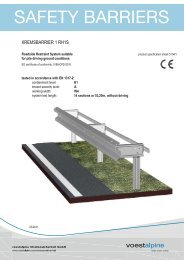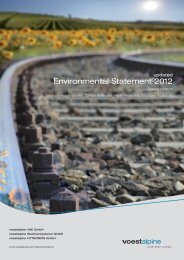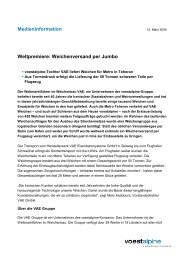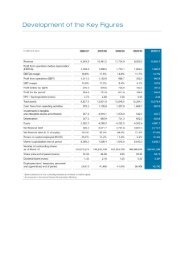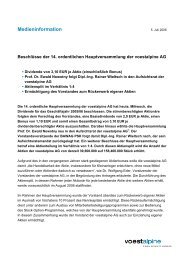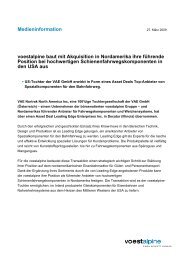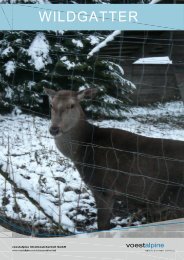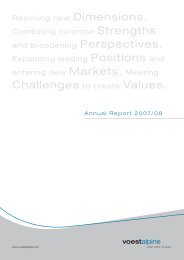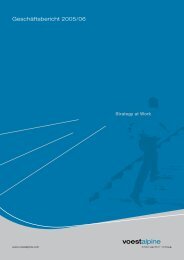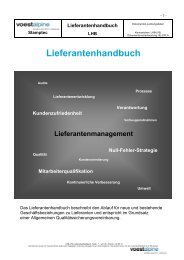Wear-resistant steels - voestalpine
Wear-resistant steels - voestalpine
Wear-resistant steels - voestalpine
You also want an ePaper? Increase the reach of your titles
YUMPU automatically turns print PDFs into web optimized ePapers that Google loves.
<strong>Wear</strong>-<strong>resistant</strong> <strong>steels</strong><br />
Technical terms of delivery for heavy plates<br />
<strong>voestalpine</strong> Grobblech GmbH<br />
www.<strong>voestalpine</strong>.com/grobblech
<strong>Wear</strong>-<strong>resistant</strong> <strong>steels</strong><br />
durostat ®<br />
Steel grades<br />
durostat 400<br />
durostat 450<br />
durostat 500<br />
durostat B2<br />
Subject to change pursuant to further development.<br />
The current version is available at www.<strong>voestalpine</strong>.com/grobblech.<br />
Technical terms of delivery for heavy plates durostat ® January 2013.<br />
2
durostat 400, durostat 450, durostat 500<br />
The steel grades durostat 400, durostat 450 and durostat 500 are wear-<strong>resistant</strong> special <strong>steels</strong> with hardness<br />
of approx. 400 HB, 450 HB resp. 500 HB. These <strong>steels</strong> provide high levels of resistance to mechanical wear<br />
and are specially suitable for components exposed to heavy abrasion, e.g. loading devices, shovels of wheel<br />
loaders, bodies of trough tipping wagons, conveyors, excavator components, road machines, screens and<br />
crushers.<br />
Steel grades<br />
Steel grades<br />
Steel grades<br />
durostat 400<br />
durostat 450<br />
durostat 500<br />
Production Process<br />
The technical terms of delivery apply for plate<br />
thicknesses from 5/16" - 4" for durostat 400, for<br />
plate thicknesses from 5/16" - 1 1/4" for durostat<br />
450 and for plate thicknesses from 3/8" - 1 1/4"<br />
for durostat 500.<br />
The steel grades durostat 400, durostat 450 and durostat 500 are produced via the LD-route.<br />
Table 1:<br />
Steel grades<br />
Technical terms of delivery for heavy plates durostat ® January 2013.<br />
3
Chemical composition<br />
Heat analysis<br />
Guaranteed values<br />
Steel grades mass in %<br />
C Si Mn P S Altot. Cr Mo B Ti<br />
max. max. max. max. max. min. max. max. max. max.<br />
durostat 400 0.18 0.60 2.10 0.025 0.010 0.020 1.00 0.50 0.005 0.050<br />
durostat 450 0.22 0.60 2.10 0.025 0.010 0.020 1.00 0.50 0.005 0.050<br />
durostat 500 0.30 0.60 2.10 0.025 0.010 0.020 1.00 0.50 0.005 0.050<br />
The steel is fine-grain melted and can contain microalloying elements such as Nb and V.<br />
Carbon equivalent<br />
Standard values<br />
Steel grades mass in %<br />
As-delivered condition<br />
The high level of hardness is achieved by online accelerated cooling or conventional quenching.<br />
Hardness<br />
CEV 1) CET 2)<br />
durostat 400 0.47 0.30<br />
durostat 450 0.68 0.43<br />
durostat 500 0.53 0.41<br />
1) CEV = C + Mn/6 + (Cr + Mo + V)/5 + (Ni + Cu)/15, according to IIW<br />
2) CET = C + (Mn + Mo)/10 + (Cr + Cu)/20 + Ni/40, according to SEW 088<br />
Hardness in as-delivered condition<br />
Hardness<br />
Steel grades HB<br />
durostat 400 360 - 440<br />
durostat 450 410 - 490<br />
durostat 500 460 - 540<br />
Table 2:<br />
Chemical<br />
composition<br />
Table 3:<br />
Carbon<br />
equivalent<br />
Technical terms of delivery for heavy plates durostat ® January 2013.<br />
4
Mechanical properties<br />
Standard values for as-delivered condition (plate thickness of 0.787")<br />
Quality test<br />
Brinell hardness is measured according to ISO 6505 per heat and for every 88,000 pounds (40 mt).<br />
Hardness is measured approx. 0.04" (1 mm) under the surface. The heat analysis is provided as<br />
proof of the chemical composition.<br />
Tolerances and surface finish<br />
Unless otherwise agreed, tolerances according to EN 10029 (thickness<br />
tolerance according to class A, flatness tolerance according to class N)<br />
and surface finish according to EN 10163-A1 are valid.<br />
Marking<br />
In general, marking consists of:<br />
<strong>voestalpine</strong> symbol<br />
Steel grade designation<br />
Heat number<br />
Plate number<br />
Material testing certificate<br />
Type of certificate according to EN 10204 must be agreed upon ordering.<br />
Processing guidelines<br />
Cold forming<br />
Fracture elongation<br />
Yield strength Tensile strength L 0 = 5,65 √ S 0<br />
Steel grades MPa MPa %<br />
durostat 400 1,000 1,250 10<br />
durostat 450 1,100 1,400 9<br />
durostat 500 1,200 1,550 8<br />
durostat 400, durostat 450 and durostat 500 can be cold formed if the high hardness is taken into account.<br />
The prerequisite for cold forming is the proper preparation of the cut edges. Grinding of the flame- or<br />
shear-cut edges in the bending area is recommended. Due to the high level of hardness, bending must<br />
take place slowly and steadily.<br />
Table 4:<br />
Mechanical<br />
properties<br />
Technical terms of delivery for heavy plates durostat ® January 2013.<br />
5
Recommended minimum bending radii<br />
Position of the bending edge to the rolling directionsmallest permitted bending radius<br />
durostat 400 durostat 450 durostat 500<br />
Longitudinal 4 x plate thickness 5 x plate thickness 5 x plate thickness<br />
Transverse 3 x plate thickness 4 x plate thickness 4 x plate thickness<br />
Heat treatment<br />
In order to maintain its hardness, durostat 400, durostat 450 and durostat 500 may not be heated<br />
above 392 °F (200 °C).<br />
Welding<br />
General information<br />
Due to their chemical composition, plates of durostat 400, durostat 450 and durostat 500 are well-suited<br />
for welding. All tested fusion welding methods can be employed, but metal inert gas shielded arc welding<br />
has proved especially effective (low hydrogen input). For reasons of crack prevention, basic-coated<br />
electrodes with controlled hydrogen content should be used for manual electric arc welding. Prior to<br />
welding, the electrodes must be dried according to manufacturer instructions. The diffusible hydrogen<br />
content should be HD < 5 ml/100 g WM.<br />
Filler materials and welding conditions (preheating, welding parameters)<br />
The selection of the fillers depends on the strength requirements made on the welded joint. The following<br />
filler materials have proved practically:<br />
Recommended filler materials<br />
Electrodes Inert gas welding wire<br />
E 7018-1 (e. g. Böhler FOX EV 50) ER 80 S-G (e. g. Böhler DMO-IG)<br />
E 7018-1 (e. g. Böhler FOX EV 50) ER 80 S-G (e. g. Böhler DMO-IG)<br />
for welded joints of higher strength<br />
E 10018-G (M) ER 110 S-G<br />
(e. g. Böhler FOX EV 75) (e. g. Böhler X70-IG)<br />
If the design requires that the welds have the same wear-resistance as the base material, the top layers<br />
can be welded with wear-<strong>resistant</strong> electrodes (e.g. UTP DUR 400 or UTP DUR 600) or equivalent inert<br />
gas welding wires.<br />
In order to minimise the risk of cold cracks, preheating according to picture 1 is recommended as well as<br />
postheating (302 - 392 °F / 2 h) for preheating temperatures above 356 °F.<br />
Table 5:<br />
Minimum<br />
bending radii<br />
Table 6:<br />
Recommended<br />
filler materials<br />
Technical terms of delivery for heavy plates durostat ® January 2013.<br />
6
Recommended preheating temperature, durostat 400, durostat 450 and durostat 500<br />
Minimum preheating temperature [°F]<br />
428<br />
392<br />
356<br />
320<br />
284<br />
248<br />
212<br />
176<br />
140<br />
104<br />
0<br />
1/2<br />
1 1 1/2 2 2 1/2 3 3 1/2<br />
4<br />
Plate thickness [inch]<br />
Es = 1,0 kJ/mm<br />
HD = 5 ml/100 g WM<br />
durostat 450, durostat 500<br />
Recommended post-heating<br />
(302 - 392 °F / 2 h)<br />
durostat 400<br />
Recommended post-heating<br />
(302 - 392 °F / 2 h)<br />
Picture 1:<br />
Recommended<br />
preheating<br />
temperature<br />
Technical terms of delivery for heavy plates durostat ® January 2013.<br />
7
Dimensions<br />
durostat 400<br />
Thickness<br />
(inch)<br />
4<br />
3 3/4<br />
3 1/2<br />
3 1/4<br />
3<br />
2 3/4<br />
2 1/2<br />
2 1/4<br />
2<br />
1 3/4<br />
1 1/2<br />
1 1/4<br />
1<br />
3/4<br />
1/2<br />
3/8<br />
5/16<br />
Width<br />
(inch)<br />
Maximum length: 520"<br />
60<br />
Different dimensions on request.<br />
65<br />
70<br />
75<br />
80<br />
85<br />
90<br />
95<br />
100<br />
Technical terms of delivery for heavy plates durostat ® January 2013.<br />
8
Dimensions<br />
durostat 450<br />
Thickness<br />
(inch)<br />
1 1/4<br />
1<br />
3/4<br />
1/2<br />
3/8<br />
5/16<br />
Width<br />
(inch)<br />
Maximum length: 520"<br />
60<br />
Different dimensions on request.<br />
65<br />
70<br />
75<br />
80<br />
85<br />
90<br />
95<br />
100<br />
Technical terms of delivery for heavy plates durostat ® January 2013.<br />
9
Dimensions<br />
durostat 500<br />
Thickness<br />
(inch)<br />
1 1/4<br />
1<br />
3/4<br />
1/2<br />
3/8<br />
Width<br />
(inch)<br />
Maximum length: 520"<br />
60<br />
Different dimensions on request.<br />
65<br />
70<br />
75<br />
80<br />
85<br />
90<br />
95<br />
100<br />
Technical terms of delivery for heavy plates durostat ® January 2013.<br />
10
durostat B2<br />
durostat B <strong>steels</strong> are heat-treatable <strong>steels</strong> delivered in as-rolled condition for components in agri-<br />
cultural machines (e.g. ploughs and harrows), cutting edges for front-end loaders or brick-molding<br />
boxes.<br />
Steel grades<br />
Steel grades<br />
Steel grades<br />
durostat B2<br />
Production process<br />
durostat B2 <strong>steels</strong> are produced via the LD-route.<br />
The technical terms of delivery apply for plate<br />
thicknesses from 5/16" - 2".<br />
Table 1:<br />
Steel grades<br />
Technical terms of delivery for heavy plates durostat ® January 2013.<br />
11
Chemical composition<br />
Heat analysis<br />
Guaranteed values<br />
Steel grades mass in %<br />
C Si Mn P S Altot. Cr Ti B B<br />
max. max. max. max. max. min. max. max. min. max.<br />
durostat B2 0.30 0.60 2.10 0.025 0.010 0.020 0.80 0.050 0.0005 0.0050<br />
The steel is fine-grain melted and can contain microalloying elements such as Nb and V.<br />
As-delivered condition<br />
The plates are delivered in as-rolled condition (hot-rolled, untreated), since usually heat treatment such<br />
as quenching or tempering is carried out on the finished parts.<br />
Mechanical properties<br />
Standard values for as-rolled conditions (plate thickness of 0.787")<br />
Quality test<br />
Yield strength Tensile strength<br />
Fracture elongation<br />
L = 5,65 √ S 0 0 Hardness<br />
Steel grades MPa MPa % HB<br />
durostat B2 400 650 20 200<br />
Achievable hardness (following quenching in water)<br />
Hardness<br />
Steel grades HB<br />
durostat B2 approx. 500<br />
The heat analysis is provided as proof of the chemical composition.<br />
Table 2:<br />
Chemical<br />
composition<br />
Table 3:<br />
Mechanical<br />
properties<br />
Table 4:<br />
Achievable<br />
hardness<br />
Technical terms of delivery for heavy plates durostat ® January 2013.<br />
12
Tolerances and surface finish<br />
Unless otherwise agreed, tolerances according to EN 10029 (thickness tolerance according to class A,<br />
flatness tolerance according to class N) and surface finish according to EN 10163-A1 are valid.<br />
Marking<br />
In general, marking consists of:<br />
<strong>voestalpine</strong> symbol<br />
Steel grade designation<br />
Heat number<br />
Plate number<br />
Material testing certificate<br />
Type of certificate according to EN 10204 must be agreed upon ordering.<br />
Processing guidelines<br />
Hot forming and heat treatment<br />
durostat B steel plates can be hot formed and machined in untreated condition.<br />
Cold forming in as-rolled condition is only possible to a limited extent.<br />
Hot forming and heat treatment temperatures<br />
Quenching<br />
and tempering in<br />
Hot forming water oil<br />
Steel grade °F °F °F<br />
durostat B2 593 - 427 465- 482 482 - 500<br />
Welding<br />
General information<br />
The high hardness of approx. 500 HB of durostat B2 steel grade is obtained by alloying boron.<br />
The chemical composition with a relatively low carbon content provides good weldability.<br />
Due to their high strength and good hardenability, durostat B2 grades require extra care during<br />
welding.<br />
The generally valid and accepted rules for the welding of low-alloyed, higher-strength fine-grain<br />
structural steel according to EN 1011-2 and STAHL-EISEN Werkstoffblatt (SEW) 088 are to be<br />
observed.<br />
Filler materials and welding conditions (preheating, welding parameters)<br />
The selection of the fillers depends on the strength requirements made on the welded joint.<br />
The following filler materials have proved practically:<br />
Table 5:<br />
Heat<br />
treatment<br />
Technical terms of delivery for heavy plates durostat ® January 2013.<br />
13
Recommended filler materials<br />
If the design requires that the welds have the same wear-resistance as the base material, the top layers<br />
can be welded with wear-<strong>resistant</strong> electrodes (e.g. UTP DUR 400 or UTP DUR 600) or equivalent inert<br />
gas welding wires. For reasons of cold cracking prevention, the hydrogen content in the weld material<br />
should be very low (HD < 5 ml/100 g WM). This is generally guaranteed by inert gas shielded welding<br />
with solid wire. Basic electrodes must be subjected to secondary drying according to manu facturers instructions<br />
in order to maintain this hydrogen criterion.<br />
In order to prevent excessive hardening in the heat-affected zone and to obtain a high level of resistance<br />
against hydrogen-induced cracks, preheating according to picture 1 and postheating (302 - 392 °F / 2 h)<br />
for plate thicknesses above 1 1/4" is recommended.<br />
For specific applications, the precise preheating temperature can be established according to SEW 088<br />
or EN 1011-2 on the basis of the chemical composition of the plate to be processed and the selected<br />
welding parameters.<br />
Welding parameters which lead to cooling times t 8/5 of 10 - 20 seconds, have proved effective. They<br />
result in optimum mechanical-technological properties (strength, toughness etc.) of the welds.<br />
Recommended preheating temperature, durostat B2<br />
Minimum preheating temperature [°F]<br />
Welding Electrodes Inert gas welding wire<br />
before hardening E 7018-1 (e. g. Böhler FOX EV 50) ER 80 S-G (e. g. Böhler DMO-IG)<br />
after hardening E 7018-1 (e. g. Böhler FOX EV 50) ER 80 S-G (e. g. Böhler DMO-IG)<br />
428<br />
392<br />
356<br />
320<br />
284<br />
248<br />
212<br />
176<br />
140<br />
104<br />
for welded joints of higher strength<br />
E 10018-G (M) ER 110 S-G<br />
(e. g. Böhler FOX EV 75) (e. g. Böhler X70-IG)<br />
Es = 1.0 kJ/mm<br />
HD = 5 ml/100 gSG<br />
Recommended postheating<br />
(302 - 392 °F / 2 h)<br />
0 1/2<br />
1 1 1/2 2 2 1/2 3 3 1/2<br />
4<br />
Plate thickness [inch]<br />
Table 6:<br />
Recommended<br />
filler materials<br />
Picture 1:<br />
Recommended<br />
preheating<br />
temperature<br />
Technical terms of delivery for heavy plates durostat ® January 2013.<br />
14
Dimensions<br />
durostat B2<br />
Thickness<br />
(inch)<br />
2<br />
1 3/4<br />
1 1/2<br />
1 1/4<br />
1<br />
3/4<br />
1/2<br />
3/8<br />
5/16<br />
Width<br />
(inch)<br />
Maximum length: 740"<br />
60<br />
Different dimensions on request.<br />
65<br />
70<br />
75<br />
80<br />
85<br />
90<br />
95<br />
100<br />
Technical terms of delivery for heavy plates durostat ® January 2013.<br />
15
Technically more advanced. Successful together.<br />
<strong>voestalpine</strong> Steel Division – the partner you can trust.<br />
<strong>voestalpine</strong> Grobblech GmbH<br />
<strong>voestalpine</strong>-Straße 3<br />
4020 Linz, Austria<br />
T. +43/50304/15-9440<br />
F. +43/50304/55-9440<br />
grobblech@<strong>voestalpine</strong>.com<br />
www.<strong>voestalpine</strong>.com/grobblech<br />
High-quality materials are the basis for our products. We strive to be the best partner for our<br />
customers and want to provide them with the best-possible solution. We focus our expertise<br />
on two aspects:<br />
The personal aspect, with dedicated and highly competent employees<br />
The technical aspect, with high-quality methods, products and services<br />
The companies in the <strong>voestalpine</strong> Steel Division and their employees understand partnership<br />
to be the following:<br />
Understanding for their customers’ business<br />
Expertise and reliability<br />
Responsibility for satisfactory project completion<br />
Partnerships based on trust<br />
Many years of successful partnerships with our customers prove our point.



